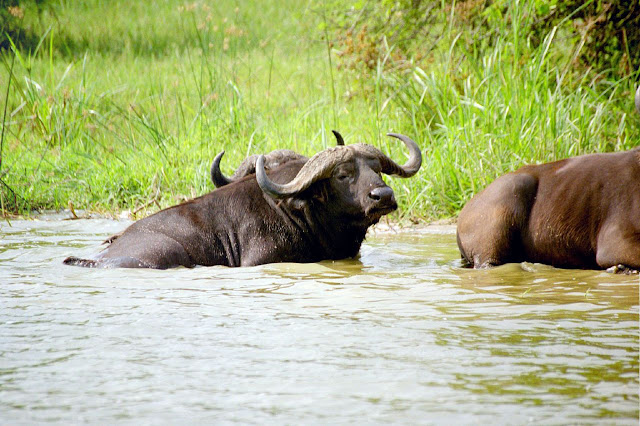ZULA
BUFFALOS
Buffalo are social animals and live in groups
called herds. Water buffalo herds are segregated by gender.
Young males stay with the maternal herd for
about three years, and then they join a male herd. Maternal herds have up to 30
females and their offspring. Male herds have up to 10 members
. African buffalo herds are mostly of mixed
gender. They do have a few all-male herds, but these usually consist of old
males. An African herd often has more than 1,000 members.
African buffalo is the only species of wild cattle that can
be found in Africa. It is also known as Cape buffalo, forest buffalo and
savanna buffalo. African buffalo inhabits sub-Saharan parts of Africa.
There are four subspecies of African buffalo that differs in
color, size and type of habitat where they can be found. African buffalo lives
in open woodlands, savannas, forests, and lowland rainforests. Since African
buffalo depends on water, it requires habitats that receive at least 10 inches
of rain per year. African buffalo is sensitive to habitat loss, hunt and
diseases (induced by rinderpest virus), but it is not endangered
DIET
Buffalo are herbivores, and so eat only
vegetation. Their favorite foods are grass and herbs, but water buffalo will
also eat aquatic plants. Both African and Asian buffalo will eat shrubs and
trees when they can't find grass or herbs to eat.
OFFSPRING
Buffalo, like most mammals, bear live young,
which are called calves. Usually, they have one calf at a time, and the female
will carry the calf for a gestation period of 9 to 11 months before giving
birth. Once the calf is born, a water buffalo will stay with its mother for
around three years. Then, male calves will be moved to the all-male herd, while
the female calves stay with the female herd. Females become pregnant every
other year.
Water buffalo tend to live around 25 years, according to
the University
of Michigan, while African
buffalo live around 26 years.
INTERESTING
AFRICAN BUFFALO FACTS:
African buffalo is large animal that can reach 6.8 to 11 feet in
length, 3.2 to 5.6 feet in height and weight between 660 and 1900 pounds.
African buffalo has large head, broad chest and strong legs. It
is four times stronger than ox.
Body of African buffalo is covered with hair that can be brownish
to black in color.
Horns of African buffalo are shaped like question marks. Males
have longer and thicker horns.
African buffalo is a grazer. It feed mainly on the grass. When
the grass sources are scarce, it may eat shrubs and trees.
African buffalos live in large herds that sometimes include
thousand animals. Usually, herds are smaller, with up to 12 animals on average.
Herds usually consist of females, their offspring and one or
more males. Males that are not part of the herd can form bachelor herds, or
live a solitary life.
Solitary animals are easy target of lions, which are their
natural enemies.
Life in herd ensures certain advantages. Animals are well
informed about the best feeding areas and sources of water. Besides that, they
are protected against the predators.
When faced with predators, animals of the herd form a circle
around the young, old or weak animals, exposing their large and sharp horns
toward the predators. This barrier is very effective and prevents predators to
reach the animals that are not strong enough to fight.
African buffalo is well known for its exceptional memory. It
will recognize a person (such as hunters) that hurt it in the past and it will
attack it at their next encounter. Same is with lions. They will
"preventively" kill cubs of lions that are known attackers of the
herd.
African buffalo has poor eyesight and sense of hearing, but
their sense of smell is excellent.
Mating season of African buffalo takes place between March and
May. Pregnancy lasts 11 and half months and ends with one baby (calf).
Bond between mother and calf is very strong. Calf is completely
dependent on its mother during the period of suckling, which lasts one year.
Average lifespan of the African buffalo in the wild is 20 years.




Comments
Post a Comment